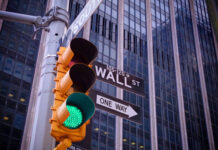Markets
Yesterday, especially US bond markets further adapted to guidance that persistent high inflation will require the Fed to raise its target rate well above 5.0% to stay there for a long period of time. US data were mixed. Jobless claims (194k) brought more evidence of a tight labour market. In line with the CPI on Tuesday, US PPI inflation reaccelerated more than expected to 0.7% M/M for the headline and 0.6% for the core measure, resulting in Y/Y readings of 6.0% and 4.5% respectively. On the other hand housing starts and permits declined more than expected and the Philly Fed business outlook posted an awful miss (-24.3 from -8.9 vs -7.5 expected). However, contrary to what would have happened a few weeks ago, it didn’t hinder the reigning trend to higher yields. It was again longer yields taking the lead with the curve turning a bit less inverse. The US 2-y yield gained 0.9 bp. The 30-y added 7.3 bps. Later in the session, Fed’s Bullard further reopened the debate on a 50 bps step at the March meeting, joining recent signs from Fed’s Mester. Changes in German yields due to a late session intraday comeback were smaller (less than 1 bp across the curve). Even so, the 2-y German yield holds at the cycle peak (2.88%) while the 10-y tested the 2.50% barrier intraday. The EMU 10-y swap is holding north of 3.0%. After remarkable resilience of equity markets to the rise in yields of late, charts yesterday showed some tentative cracks. After nervous intraday swings, US indices lost between 1.26% (Dow) and 1.78% (Nasdaq). The Euro Stoxx 50 stayed in green (+0.40%) but off the intraday peak. The dollar gradually gained further ground (EUR/USD close 1.0674, DXY 103.85), even as there was still some hesitation intraday. Sterling lost further ground with EUR/GBP closing just north of 0.89. BoE’s Pill indicated that the pace of BoE hikes might slow and warned on the risk of overtightening.
This morning, Asian markets felt the spill-over from the losses on WS, with most regional indices ceding about 0.5%-1.0%. US yields continue drifting higher (2-4 bps). The risk-off also propels the dollar above first resistance (DXY currently at 104.5, EUR/USD 1.064; USD/JPY 134.75). There are hardly any eco data with market moving potential in EMU or in the US. We look out for speeches of ECB’s Villeroy and especially Fed’s Barkin (on the labour market). Both European (cfr supra) and US yields are near important technical levels going into the weekend. The US 2-y yield (4.67%) is closing in on the cycle top of 4.80%. The 10-y is testing the January top of 3.90%. A break would be highly significant. After 10 days of ‘consolidation’, the dollar finally might get additional support from a less bright risk sentiment. EUR/USD breaking below the 1.0735/1.0656 area opens the way for a return to the 1.0484 2023 low. This morning, UK retail sales printed better than expected (ex-auto fuels 0.4% M/M and -5.3% Y/Y). Sterling gains a few ticks immediately after the release, but we doubt the it will be a (positive) game-changer for sterling.
News Headlines
RBA governor Lowe in before the House on Thursday stuck to his view expressed in the Senate that more rate hikes are needed to crush inflation. He refrained from giving estimates for the terminal rate, saying that it is dependent on how the (world) economy and inflation evolves and the job outlook. Regarding the latter, Lowe downplayed the January labour market report, which wasn’t available yet at the Senate hearing and showed employment growth declining for a second month straight. It didn’t change his overall assessment, explaining that seasonal factors typically affect both December and January data. Lowe did say he would likely reassess the outlook if the February report was weak too. Australian government bond yields jump between 5 and 8.8 bps, steepening the curve. AUD/USD loses some ground but this is mainly due to overall USD strength. The pair fell from 0.6879 to 0.684.
US household debt jumped by the most in two decades in Q4 last year, data from the NY Fed showed. By adding a whopping $394bn (nominal), total overall debt now stands at a record $16.9tn. Mortgage balances remain the biggest form of debt ($11.92tn) and spurred the surge while mortgage originations due to the aggressive Fed tightening campaign fell to the lowest since 2019. But the increase was broad-based. Credit cards registered the largest jump since recording began in 1999. Overall delinquency rates remain below pre-pandemic levels but are rising fast. Losing one’s job is usually the reason for delinquencies to pick up. But with the unemployment rate at historically low levels, the NY Fed concludes that the recent rise is more due to inflation and rising rates.














